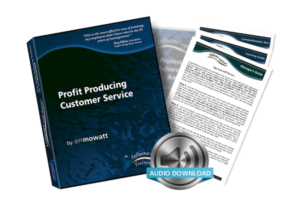Making Connections
Building first impressions with any customer instantly
We all know the power of first impressions. How people perceive us during the first few seconds of an encounter has a major influence on whether they will trust us, be attracted to us, or want to do business with us. To create a positive first impression, we need to know how to connect immediately with others regardless of their age, gender, ethnic background, mood, or the situation.
Let’s begin by testing your “first impression awareness.” What would you think of the waiter in the following situation? You’re having a business lunch with a potential client. She’s telling you about what she doesn’t like about her current supplier. You’re thinking, “This stuff is gold — please keep talking.” Suddenly, the waiter comes in and starts his canned speech, “My name’s Mike, I’ll be your waiter. And how are you today? Today’s specials are . . . ”
Chances are, your first impression of the waiter would be negative. In fact, that waiter’s speech is a great example of what not to do when meeting someone for the first time. Ironically, he was probably doing just what he was told to do.
Unfortunately, most managers don’t provide competent training for their employees on how to establish rapport. Huge mistake — as we see in the waiter example. Instead, employees are given a script to read. Franchise operations love scripts. They think that this “systematic” approach to dealing with customers is their greatest strength — which is true. It’s also their greatest weakness.
The problem with the canned script approach is that the customer recognizes a script, senses that the employee has no genuine feeling or empathy with what the customer really needs, and therefore does not trust (or in the case of our waiter even like) the employee.
Instead of canned speeches, use a thirty second technique that generates trust, feelings of empathy, and makes people want to do business with you. Unfortunately, there’s been a lot of misleading information out there about this method. Let’s get the real story about how and why you can get such phenomenal results when you properly use technique known as mirroring.
The Mirroring Technique
Mirroring is based on the assumption that we tend to feel comfortable with people who communicate non verbally the way we do. In other words, we are drawn to people when their body language (gestures, tone of voice, facial expressions, eye contact, dress, and so on) is similar to ours.
Forget canned speeches. They have as much appeal as over-used pick-up lines in singles bars.”
By the same token, we tend to be “turned off ” by people who’s non verbal language is different than ours. For example, if you are engaged in a quiet conversation with a friend at a party, you will probably perceive the person whose loud, boisterous voice bellows in the background, as being obnoxious.
The great news is we are in control of our nonverbal communication. So to create rapport with others instantly, we merely need to “mirror” their non-verbal communication. That means if the other person talks softly, then you talk more softy. If they lean forward, then you lean forward. If they talk quickly then you do the same. In other words, you ‘mirror’ the other person’s tone of voice and body language. The only exception is when they are angry. In that situation, you wouldn’t mirror anger; you’d instead mirror concern.
In the case of our waiter, if he’d been trained with the mirroring technique, he wouldn’t have started talking until his customers ceased their conversation and made eye contact with him. Then he would mirror the seriousness of the mood they conveyed, skip the opening canned speech, get directly to the point and ask something like, “Something to drink?” In this case his customers would have appreciated the waiters businesslike approach and felt good about their choice of restaurant.
There are a few things to keep in mind though when we use mirroring. First, mirroring does not mean “mimicking.” So, if the other person is sitting with arms folded across their chest, you may have yours crossed on your lap. Don’t mirror the person exactly; just similarly. That prevents people from thinking they’re being imitated.
It may come as a relief to know that you don’t have to mirror the other person for longer then a few moments. Once they become comfortable with you, you can actually start leading the nonverbal communication, and then they’ll start following you. So if you have a friend who’s tired or listless you need to start the conversation in a low slow manner. After a few minutes, you gradually pick up the tempo. Your friend will feel so comfortable with you, they’ll naturally do the same. This is great news particularly if you interact with lots of people.
Mirroring is easy and it works. When you use it properly, you’ll improve the impression you make on virtually anyone — regardless of their mood or the situation. You’ll also experience the personal satisfaction of making a stranger feel comfortable. That’s when you begin making truly important connections.
Written By Jeff Mowatt (original content – not AI generated)
Was this helpful? You’ll find more articles on this topic Greeting Customers and Establishing Trust
You’ll find more of Jeff’s Trusted Advisor Customer Service tips or subscribe to receive a new Business Building Tip every two weeks.
This article is based on Jeff’s best-selling book, Influence with Ease

You already know that whatever your message, customers and coworkers are persuaded – not by your title – but by how much they trust you. Jeff shares 30-second tips that strengthen trust in virtually all of your communications.

Jeff’s self-study training kit “Profit Producing Customer Service” this training package reveals how employees can provide REMARKable service in all areas related to customer service.

Trusted Advisor Transformation© Online Course 15 minutes a day for 7 days. View on any computer or mobile device. Communication secrets that position you as a Trusted Advisor
You can find more of Jeff’s training resources under Shop or should you be interested in having Jeff present a customized presentation for your organization or next event, contact Jeff at [email protected]

